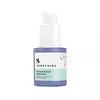What's inside
What's inside
 Key Ingredients
Key Ingredients

 Benefits
Benefits

 Concerns
Concerns

 Ingredients Side-by-side
Ingredients Side-by-side

Water
Skin ConditioningPropylene Glycol
HumectantGlycerin
HumectantPhenoxyethanol
PreservativeCarbomer
Emulsion StabilisingPEG-40 Hydrogenated Castor Oil
EmulsifyingCaprylic/Capric Triglyceride
MaskingCamellia Sinensis Leaf Extract
AntimicrobialMethyl Methacrylate Crosspolymer
Polyglutamic Acid
Skin ConditioningTetrasodium EDTA
Retinol
Skin ConditioningHydrogenated Lecithin
EmulsifyingEthylhexylglycerin
Skin ConditioningCholesterol
EmollientBiosaccharide Gum-1
HumectantTocopheryl Acetate
AntioxidantRubus Idaeus Fruit Extract
AstringentBHT
AntioxidantPunica Granatum Extract
AstringentButylene Glycol
HumectantPhaseolus Radiatus Seed Extract
Skin ConditioningBHA
AntioxidantAvena Sativa Meal Extract
SoothingPalmitoyl Hexapeptide-12
Skin ConditioningWater, Propylene Glycol, Glycerin, Phenoxyethanol, Carbomer, PEG-40 Hydrogenated Castor Oil, Caprylic/Capric Triglyceride, Camellia Sinensis Leaf Extract, Methyl Methacrylate Crosspolymer, Polyglutamic Acid, Tetrasodium EDTA, Retinol, Hydrogenated Lecithin, Ethylhexylglycerin, Cholesterol, Biosaccharide Gum-1, Tocopheryl Acetate, Rubus Idaeus Fruit Extract, BHT, Punica Granatum Extract, Butylene Glycol, Phaseolus Radiatus Seed Extract, BHA, Avena Sativa Meal Extract, Palmitoyl Hexapeptide-12
Water
Skin ConditioningGlycerin
HumectantButylene Glycol
HumectantSqualane
EmollientSaccharomyces Ferment Filtrate
HumectantNeopentyl Glycol Diheptanoate
EmollientCetyl Ethylhexanoate
EmollientDipentaerythrityl Hexa C5-9 Acid Esters
Skin ConditioningBetaine
HumectantPentylene Glycol
Skin ConditioningPolyglycerin-3
HumectantDimethyl Isosorbide
Solvent1,2-Hexanediol
Skin ConditioningIsoamyl P-Methoxycinnamate
UV AbsorberTocopherol
AntioxidantBisabolol
MaskingHydrogenated Olive Oil Unsaponifiables
EmollientAllantoin
Skin ConditioningTromethamine
BufferingAlbatrellus Confluens Extract
HumectantAcrylates/C10-30 Alkyl Acrylate Crosspolymer
Emulsion StabilisingHydrogenated Lecithin
EmulsifyingHydroxypinacolone Retinoate
Skin ConditioningXanthan Gum
EmulsifyingSodium Hyaluronate
HumectantSodium Dilauramidoglutamide Lysine
HumectantSodium Phytate
Ethylhexylglycerin
Skin ConditioningBenzyl Alcohol
PerfumingDehydroacetic Acid
PreservativeWater, Glycerin, Butylene Glycol, Squalane, Saccharomyces Ferment Filtrate, Neopentyl Glycol Diheptanoate, Cetyl Ethylhexanoate, Dipentaerythrityl Hexa C5-9 Acid Esters, Betaine, Pentylene Glycol, Polyglycerin-3, Dimethyl Isosorbide, 1,2-Hexanediol, Isoamyl P-Methoxycinnamate, Tocopherol, Bisabolol, Hydrogenated Olive Oil Unsaponifiables, Allantoin, Tromethamine, Albatrellus Confluens Extract, Acrylates/C10-30 Alkyl Acrylate Crosspolymer, Hydrogenated Lecithin, Hydroxypinacolone Retinoate, Xanthan Gum, Sodium Hyaluronate, Sodium Dilauramidoglutamide Lysine, Sodium Phytate, Ethylhexylglycerin, Benzyl Alcohol, Dehydroacetic Acid
 Reviews
Reviews

Ingredients Explained
These ingredients are found in both products.
Ingredients higher up in an ingredient list are typically present in a larger amount.
Butylene Glycol (or BG) is used within cosmetic products for a few different reasons:
Overall, Butylene Glycol is a safe and well-rounded ingredient that works well with other ingredients.
Though this ingredient works well with most skin types, some people with sensitive skin may experience a reaction such as allergic rashes, closed comedones, or itchiness.
Learn more about Butylene GlycolEthylhexylglycerin (we can't pronounce this either) is commonly used as a preservative and skin softener. It is derived from glyceryl.
You might see Ethylhexylglycerin often paired with other preservatives such as phenoxyethanol. Ethylhexylglycerin has been found to increase the effectiveness of these other preservatives.
Glycerin is already naturally found in your skin. It helps moisturize and protect your skin.
A study from 2016 found glycerin to be more effective as a humectant than AHAs and hyaluronic acid.
As a humectant, it helps the skin stay hydrated by pulling moisture to your skin. The low molecular weight of glycerin allows it to pull moisture into the deeper layers of your skin.
Hydrated skin improves your skin barrier; Your skin barrier helps protect against irritants and bacteria.
Glycerin has also been found to have antimicrobial and antiviral properties. Due to these properties, glycerin is often used in wound and burn treatments.
In cosmetics, glycerin is usually derived from plants such as soybean or palm. However, it can also be sourced from animals, such as tallow or animal fat.
This ingredient is organic, colorless, odorless, and non-toxic.
Glycerin is the name for this ingredient in American English. British English uses Glycerol/Glycerine.
Learn more about GlycerinHydrogenated Lecithin is created from the hydrogenation of lecithin (a group of phospholipids). Hydrogenation is a chemical reaction between hydrogen and another element.
This ingredient is an emollient and emulsifier. As an emollient, it helps soften skin by trapping moisture within. As an emulsifier, it prevents oil and water ingredients from separating.
Water. It's the most common cosmetic ingredient of all. You'll usually see it at the top of ingredient lists, meaning that it makes up the largest part of the product.
So why is it so popular? Water most often acts as a solvent - this means that it helps dissolve other ingredients into the formulation.
You'll also recognize water as that liquid we all need to stay alive. If you see this, drink a glass of water. Stay hydrated!
Learn more about Water